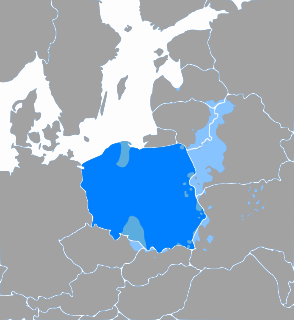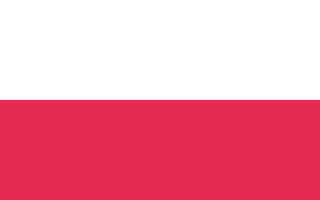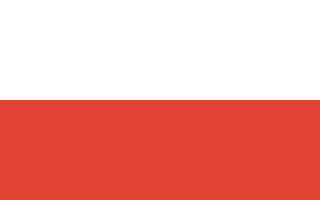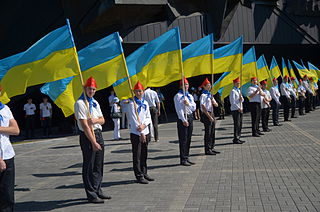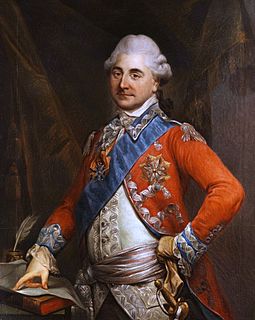
Stanisław II Augustus, who reigned as King of Poland and Grand Duke of Lithuania from 1764 to 1795, was the last monarch of the Polish–Lithuanian Commonwealth. He remains a controversial figure in Polish history. Recognized as a great patron of the arts and sciences and an initiator and firm supporter of progressive reforms, he is also remembered as the King of the Commonwealth whose election was marred by Russian intervention. He is criticized primarily for his failure to stand against the partitions, and thus to prevent the destruction of the Polish state.
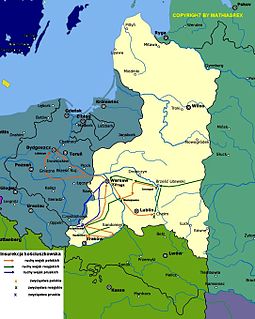
The Kościuszko Uprising was an uprising against the Russian Empire and the Kingdom of Prussia led by Tadeusz Kościuszko in the Commonwealth of Poland and the Prussian partition in 1794. It was a failed attempt to liberate the Polish-Lithuanian Commonwealth from Russian influence after the Second Partition of Poland (1793) and the creation of the Targowica Confederation.

The Polish–Russian War of 1792 was fought between the Polish–Lithuanian Commonwealth on one side, and the Targowica Confederation and the Russian Empire under Catherine the Great on the other.
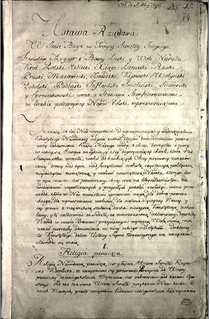
The Constitution of 3 May 1791 was adopted by the Great Sejm (parliament) of the Polish–Lithuanian Commonwealth, a dual monarchy comprising the Crown of the Kingdom of Poland and the Grand Duchy of Lithuania. The legislation was designed to redress the Commonwealth's political defects and was preceded by a period of agitation for—and gradual introduction of—reforms beginning with the Convocation Sejm of 1764 and the election of Stanisław August Poniatowski as the Commonwealth's last king.
Holidays in Poland are regulated by the Non-working Days Act of 18 January 1951. The Act, as amended in 2010, currently defines thirteen public holidays.

Stanisław Wawrzyniec Staszic was a leading figure in the Polish Enlightenment: a Catholic priest, philosopher, geologist, writer, poet, translator and statesman. A physiocrat, monist, pan-Slavist and laissez-fairist, he supported many reforms in Poland. He is particularly remembered for his political writings during the "Great (Four-Year) Sejm" (1788–92) and for his support of the Constitution of 3 May 1791, adopted by that Sejm.

Count Roman Ignacy Potocki, generally known as Ignacy Potocki, was a Polish nobleman, member of the influential magnate Potocki family, owner of Klementowice and Olesin, a politician, writer, and office holder. He was the Marshal of the Permanent Council in 1778–1782, Grand Clerk of Lithuania from 1773, Court Marshal of Lithuania from 1783, Grand Marshal of Lithuania from 16 April 1791 to 1794.

Hugo Stumberg Kołłątaj, alt. Kołłątay, was a prominent Polish constitutional reformer and educationalist, and one of the most prominent figures of the Polish Enlightenment.

The Great Sejm, also known as the Four-Year Sejm was a Sejm (parliament) of the Polish–Lithuanian Commonwealth that was held in Warsaw between 1788 and 1792. Its principal aim became to restore sovereignty to, and reform, the Commonwealth politically and economically.
Poland does not legally recognize same-sex unions, either in the form of marriage or civil unions. In 2012, the Supreme Court ruled that same-sex couples have limited legal rights in regards to the tenancy of a shared household. A few laws also guarantee certain limited rights for unmarried couples, including couples of the same sex. Same-sex spouses also have access to residency rights under EU law.

The Patriotic Party, also known as the Patriot Party or, in English, as the Reform Party, was a political movement in the Polish-Lithuanian Commonwealth in the period of the Four-Year Sejm of 1788–92, whose chief achievement was the Constitution of 3 May 1791. The reformers aimed to strengthen the ailing political machinery of the Commonwealth, to bolster its military, and to reduce foreign political influence, particularly that of the Russian Empire. It has been called the first Polish political party, though it had no formal organizational structure. The Party was inspired by the ideals of the French Revolution, and its name, proudly used by themselves, was a tribute to the Dutch Patriots.
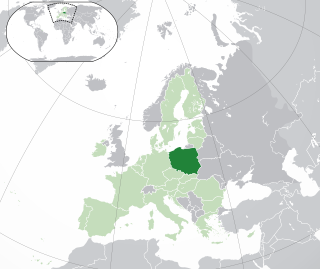
Lesbian, gay, bisexual, and transgender (LGBT) people in Poland face legal challenges not faced by non-LGBT residents. Both male and female same-sex sexual activity are legal in Poland. This was formally codified in 1932, and Poland introduced an equal age of consent for homosexuals and heterosexuals, which was set at 15. Poland provides LGBT people with the same rights as heterosexuals in certain areas: gay and bisexual men are allowed to donate blood, gays and bisexuals are allowed to serve openly in the Polish Armed Forces, and transgender people are allowed to change their legal gender following certain requirements including undergoing hormone replacement therapy. Polish law bans employment discrimination based on sexual orientation. No protections for education, health services, hate crimes and hate speech exist, however. In 2018, the Supreme Court ruled that it is illegal to deny goods and services on the basis of sexual orientation.

The Constitution of the Polish People's Republic was passed on 22 July 1952. Created by the Polish communists in the Polish People's Republic, it was based on the 1936 Soviet Constitution, and it superseded the post-war provisional Small Constitution of 1947 which, in its turn, had declared null and void the pre-war April Constitution of Poland passed by the Polish Sejm in 1935. The Russian text of the Constitution was reviewed and 'corrected' by Joseph Stalin himself, and later translated into Polish. It legalized the communist legislature and practices as they had been introduced to Poland with the Polish Committee of National Liberation in the wake of Red Army progress in 1944.
The Polish–Lithuanian and Prussian alliance was a mutual defense alliance signed on 29 March 1790 in Warsaw between representatives of the Polish–Lithuanian Commonwealth and the Kingdom of Prussia. It was signed in the brief period when Prussia was seeking an ally against either Austria or Russia, and the Commonwealth was seeking guarantees that it would be able to carry out significant governmental reforms without foreign intervention.

Jan Dekert or Jan Dekiert was a Polish merchant of German descent and political activist. Starting in the 1760s, he rose to become one of the most prominent merchants in the Polish capital of Warsaw. He was an activist arguing for more rights for the burghers in the Polish-Lithuanian Commonwealth while opposing Jewish merchants. As the representative of Warsaw, he was elected a deputy to the Sejms of 1784 and 1786, as well as to the Great Sejm (1788–1792). He was the mayor of Warsaw (1789–1790), during which period he organized the Black Procession on 2 December 1789. This was a major step towards the passing of the Free Royal Cities Act enfranchising burghers, as one of the reforms of the Great Sejm and part of the Constitution of the 3rd May, 1791.

Black procession was a demonstration held by burghers of Polish royal cities in Polish-Lithuanian Commonwealth's capital of Warsaw on 2 December 1789, during the Great Sejm. It vastly contributed to the passage of a belated major urban reform.

The Constitution of May 3, 1791 is an 1891 Romantic oil painting on canvas by the Polish artist Jan Matejko. It is a large piece, and one of Matejko's best known. It memorializes the Polish Constitution of May 3, 1791, a milestone in the history of the Polish–Lithuanian Commonwealth and the high point of the Polish Enlightenment.

Jan Suchorzewski was a Polish noble of the Zaremba coat of arms, soldier and politician. He held the title of the wojski of Wschowa. He was a deputy from Gniezno to the Sejm (parliament) of 1786 and deputy from Kalisz to the Great Sejm of 1788-1792. He would be best remembered for his dramatic, theatrical gestures from that period. Kazimierz Bartoszewicz compared Suchorzewski's look and attitude to that of Zagłoba from Henryk Sienkiewicz's famous trilogy, if more misguided. He became an opponent of the reforms, and joined the Confederation of Targowica.

Zgromadzenie Przyjaciół Konstytucji Rządowej was the first modern Polish political party, formed in May 1791, shortly after the adoption of the Constitution of May 3, 1791, by the efforts of the Patriotic Party. The purpose of the Friends of the Constitution was to defend the reformed political system and to introduce further reforms.

Armed Forces Day, known also as the Feast of the Polish Armed Forces, is a national holiday celebrated annually on 15 August in Poland, commemorating the anniversary of the 1920 victory over Soviet Russia at the Battle of Warsaw during the Polish–Soviet War. Armed Forces Day is held in conjunction with the Day of the Assumption of the Virgin Mary, itself a separate public holiday. The event is marked by military parades, equipment reviews, showcases and remembrances by all branches of the Polish Armed Forces across the country. One of the most prominent events of the day is in the capital Warsaw, which hosts a large military parade through the city's center. Originally celebrated during the Second Republic, the holiday was barred by authorities during the communist era beginning in 1947, only to be revived again in 1992.

